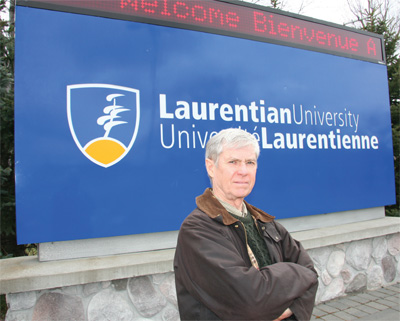
Up to 250 delegates from across Canada, the United States and other mining jurisdictions are expected to attend the Sudbury 2011 Mining & Environment International Conference at Laurentian University June 25 to 30. The conference is one of the premier international venues for sharing the latest advances in land reclamation and environmental remediation.Co-hosted by the university, the Canadian Land Reclamation Association (CLRA) and the Ontario Mining Association (OMA), the conference kicks off on June 25 and 26 with a series of short courses and features 50 to 60 presentations on June 27 and 28. There will also be a trade show with some 20 to 30 companies and field trips to Vale and Xstrata Nickel sites in the Sudbury Basin.
An awards dinner on the 28th will honour several individuals and companies for their environmental achievements. The CLRA’s Ontario chapter and the Ontario Mining Association will present the Tom Peters Memorial Mine Reclamation Award to recognize outstanding achievement in the practice of mine reclamation in Ontario, while the CLRA national body will present the Noranda Land Reclamation Award and the Dr. Edward M. Watkin Award.
The Sudbury 2011 Mining & Environment International Conference marks the 16th anniversary of the inaugural conference held in 1995.
Regreening
Sudbury’s reputation as a centre of mine reclamation expertise gained international recognition at the United Nations Conference on Environment and Development in 1992 when the city won the Local Government Honours Award for its ambitious regreening efforts.
Bill Mackasey, a retired Ministry of Northern Development and Mines land reclamation expert, traces the origins of the Sudbury Mining & Environment Conference to the buzz surrounding the award.
In 1994, Mackasey had a call from an engineer at the World Health Organization in France, who was seeking advice about a tailings area near a tributary of the Danube River that was at risk of being swamped by rising floodwaters.
“He asked me if the situation was really serious or not,” recalled Mackasey, who sits on the board of the CLRA’s Ontario chapter. “I explained that if the tailings got supersaturated with water, the whole thing could let go unless there was a really strong engineered dam holding it back.”
The two commiserated about the lack of knowledge sharing on issues relating to the environmental impacts of mining, and that prompted Mackasey to propose a conference in Sudbury.
“Mining reclamation was just starting to become a requirement in many jurisdictions and we felt there was a need to get everybody together to share their experiences and learn from each other,” he said.
The four conferences held to date have attracted an average of 350 delegates, but the 2007 conference drew close to 600.
“This year, we’re deliberately aiming for a smaller, more focused conference targeting 200 to 250 delegates,” said conference co-chair Graeme Spiers, an associate professor at Laurentian University’s Department of Chemistry, and chair of the Centre for Environmental Monitoring.
Sudbury’s reputation as a global centre of expertise in mine reclamation is closely tied to the city’s grassroots approach to environmental remediation.
Spiers, for example, recalls listening to the translation of a talk in 2001 by a Russian scientist at a mining and environment conference in Murmansk, Russia, and being surprised to hear a reference to “the Sudbury method.”
That was a good indication of the city’s reputation for expertise in environmental remediation, he said. So are the frequent invitations he and Laurentian University colleagues Peter Beckett and David Pearson receive to give talks all over the world.
Current research
Current research on the use of pulp and paper waste and municipal composts as thick covers on Sudbury area mine tailings continues to keep Sudbury in the spotlight, said Spiers.
Serving as both a hydraulic barrier and a growing medium for corn, high production grasses, poplars and willows to feed the biofuel industry, the metre-thick covers provide municipalities and pulp and paper companies with an alternative waste disposal solution while offering mining companies an economically attractive means of reclaiming tailings sites.
Several talks on the use of pulp and paper waste and municipal composts will be featured at the conference. There will also be a presentation on research aimed at using waste heat from mining operations in Sudbury to sustain a growth medium for micro-algae and produce dietary supplements such as Omega-3 fatty acids and anti-oxidants, as well as clean-burning biodiesel to fuel underground mining equipment.


